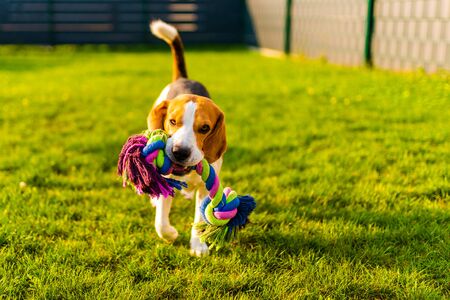Understanding Your Dog’s Needs
Before you grab the leash and head out for an adventure, it’s important to remember that every dog is unique. Matching your exercise routine to your dog’s age, breed, and health ensures not only their safety but also a tail-wagging good time for both of you!
Age Matters: Puppies vs. Adults vs. Seniors
| Life Stage | Exercise Recommendation | Why It Matters |
|---|---|---|
| Puppy (under 1 year) | Short, gentle play sessions; avoid forced running or jumping | Joints and bones are still growing; too much can cause injuries |
| Adult (1-7 years) | Daily walks, runs, fetch games; mix intensity based on breed | Most energetic stage; needs consistent activity to stay healthy |
| Senior (7+ years) | Gentle walks, light play; watch for signs of fatigue or discomfort | Aging joints and muscles need low-impact activities |
Breed Differences: Not All Paws Are Created Equal
Certain breeds are born athletes while others prefer a cozy nap on the porch. For example, herding breeds like Border Collies thrive on lots of exercise, while Bulldogs need shorter strolls due to their breathing issues. Here’s a quick guide:
| Breed Type | Ideal Exercise Style |
|---|---|
| Sporting/Herding (e.g., Labs, Shepherds) | Long walks, running, agility games |
| Toy/Companion (e.g., Pugs, Shih Tzus) | Short walks, indoor playtime, gentle fetch |
| Brachycephalic (short-nosed) Breeds (e.g., Bulldogs) | Avoid heat; opt for cool morning/evening strolls; short sessions |
| Giant Breeds (e.g., Great Danes) | Avoid strenuous exercise until fully grown; moderate walks best |
Your Dog’s Health: Listen to Their Body Language
If your pup has any medical conditions—like arthritis or hip dysplasia—it’s extra important to tailor activities to what they can handle. Look for signs such as limping, heavy panting, or reluctance to move. Always talk to your vet before starting new routines if you have concerns.
2. Warming Up Before Play
Before you let your pup zoom around the yard or hit the trails, it’s important to start with a good warm-up. Just like us, dogs need to loosen up their muscles before jumping into more active play. Skipping this step can lead to pulled muscles or other injuries—something none of us want for our four-legged friends!
Why Warming Up Matters
A proper warm-up helps increase blood flow to your dog’s muscles and gets their joints ready for action. It also gives you a chance to check if your dog is limping or feeling stiff before things get too exciting.
Easy Warm-Up Techniques
| Warm-Up Activity | How To Do It | Benefits |
|---|---|---|
| Gentle Walk | Start with a slow, 5-10 minute stroll around your yard or block. | Gradually increases heart rate and warms up muscles. |
| Light Jog | If your dog is used to jogging, add a few minutes of easy trotting after walking. | Prepares body for more intense activity. |
| Stretching | Encourage “play bows” (front legs stretched out, rear in the air), or gently guide your dog through some stretches by luring them with treats. | Improves flexibility and helps prevent strains. |
| Paw Lifts | Ask your dog to give you their paw, one at a time, several times. | Wakes up leg muscles and gets them moving smoothly. |
A Few Tips for Success
- Keep warm-ups short but consistent—just 5-10 minutes is enough for most dogs.
- Watch your dog’s body language. If they seem stiff or uncomfortable, extend the warm-up or skip vigorous activities that day.
- If you have a senior dog or a breed prone to joint issues (like Labradors or German Shepherds), warming up becomes even more important!
Remember:
A little preparation goes a long way in keeping tails wagging and paws healthy. Warming up isn’t just for human athletes—it’s a must for our furry companions too!

3. Choosing the Right Environment
Picking a safe and dog-friendly place to exercise is just as important as the activity itself. The right environment helps your pup stay happy, healthy, and injury-free. Here’s what you need to know when scouting out spots for walks, runs, or playtime.
Popular Places to Exercise Your Dog
| Location | Pros | Cons |
|---|---|---|
| Grassy Backyards | Soft on joints, familiar space, easy supervision | Potential holes, sharp objects, garden chemicals |
| Local Parks | Social opportunities, open space, walking paths | Crowds, other animals, unknown hazards (like broken glass) |
| Dog Parks | Fenced in, off-leash fun, dog interaction | Rough play injuries, disease risk if not well-maintained |
| Hiking Trails | Mental stimulation, varied terrain for exercise | Ticks, uneven ground, wildlife encounters |
| Paved Sidewalks/Paths | Easy access, consistent surface, good for leash training | Hot pavement in summer, risk of paw pad injuries, traffic nearby |
What Hazards Should You Watch Out For?
- Pesticides and Fertilizers: Avoid freshly treated lawns or gardens. Chemicals can irritate paws or be toxic if licked off fur.
- Sharp Objects: Broken glass, sharp sticks, or metal scraps can cut paws. Do a quick scan before letting your dog loose.
- Extreme Weather: Hot surfaces can burn paw pads; icy areas may cause slips. Early mornings or evenings are best in summer.
- Crowded Areas: Too many dogs or people can stress your pup and increase the chance of accidents.
- Poor Fencing: Make sure any enclosed area is secure—no gaps where curious noses can squeeze through!
- Toxic Plants: Some common plants (like azaleas or sago palm) can be dangerous if chewed. Get familiar with local flora.
- Bodies of Water: Lakes and ponds might look inviting but watch for fast currents, algae blooms, or steep banks.
Tips for Picking the Perfect Spot
- If you’re new to an area, ask neighbors or local pet groups about their favorite safe spaces.
- Bring water and a collapsible bowl so your dog stays hydrated wherever you go.
- Avoid exercising near busy roads—even the best-trained dogs can get distracted!
- If your pup has special needs (like arthritis), look for softer surfaces and gentler slopes.
- Always supervise playtime—especially with puppies or older dogs who may tire quickly.
Your Dog’s Safety Comes First!
The best environment is one where both you and your furry friend feel comfortable and secure. Take a few extra minutes to check things out before starting your adventure together—it makes all the difference for happy tails and healthy bodies!
4. Using Proper Gear
Having the right gear can make all the difference when it comes to keeping your dog safe and injury-free during exercise. Just like you wouldn’t go hiking in flip-flops, your pup shouldn’t hit the trail or neighborhood sidewalk without suitable equipment. Let’s look at what you need for a safe and fun outing.
Choosing Collars, Harnesses, and Leashes
Picking out the right collar, harness, or leash is about more than style—it’s about safety and comfort for both you and your dog. Here are some practical tips:
- Collars: Make sure it fits snugly—two fingers should fit comfortably between the collar and your dog’s neck. Avoid collars that are too tight or too loose.
- Harnesses: For dogs that pull, a well-fitted harness reduces strain on their neck and helps prevent injuries. Look for adjustable straps and padding for extra comfort.
- Leashes: Standard six-foot leashes work well for most walks. Retractable leashes can be risky in crowded areas or near traffic, so stick with sturdy, fixed-length leashes when safety is a concern.
Gear Comparison Table
| Type | Best For | Key Features |
|---|---|---|
| Flat Collar | ID tags, casual walks | Adjustable, easy to use |
| Martingale Collar | Slim-headed breeds, escape artists | Tightens gently if pulled, prevents slipping out |
| No-pull Harness | Pups who pull on leash | Distributes pressure across chest, reduces neck strain |
| Standard Leash (6 ft) | Daily walks, training | Sturdy control, less risk than retractables |
Paw Protection and Dog Footwear
If you’re walking on hot pavement in summer or icy sidewalks in winter—or hitting rough trails—paw protection can help prevent injuries like burns or cuts. Some dogs benefit from booties or paw waxes depending on conditions.
- Dog booties: Offer protection from hot asphalt, snow salt, sharp rocks, and debris.
- Paw balms/waxes: Great for moisturizing pads and providing a barrier against mild heat or cold.
Paw Protection Options at a Glance
| Paw Protection Type | When to Use |
|---|---|
| Booties | Extreme weather, rough terrain, long hikes |
| Paw Balm/Wax | Mild weather changes, dry/cracked pads prevention |
Selecting the right gear ensures every adventure is safe for your furry friend—and lets you both enjoy more time exploring together around your neighborhood or out on the trails.
5. Recognizing and Respecting Limits
Every pup is unique, just like us, and knowing when your furry friend needs a break is key to safe and happy exercise sessions. Dogs can’t always tell us when something feels off, so it’s up to us to watch for signs of tiredness or discomfort during playtime in the backyard, on hiking trails, or even just a simple walk around the neighborhood.
How to Spot Signs of Fatigue, Overheating, or Discomfort
| Sign | What It Looks Like | What To Do |
|---|---|---|
| Panting Excessively | Breathing heavily, tongue hanging out more than usual | Pause for water and rest in the shade |
| Limping or Slowing Down | Your dog falls behind, limps, or refuses to move forward | Stop exercise, check paws for injuries, head home if needed |
| Lying Down Unprompted | Your pup stops and flops down mid-activity | Let them rest as long as needed; don’t force more activity |
| Excessive Drooling or Glazed Eyes | Mouth is extra wet, eyes look unfocused or tired | Move to a cooler spot immediately, offer fresh water |
| Unusual Whining or Barking | Noises that seem out of the ordinary for your dog during walks/playtime | Stop and assess for any pain or fear triggers before continuing |
Adjusting Exercise for Your Dog’s Needs
- Mix Up Activities: Alternate between high-energy games like fetch and slower-paced sniff walks. Variety helps prevent overuse injuries.
- Keep Sessions Short: Especially with puppies and senior dogs, shorter bursts of activity are safer and more enjoyable.
- Listen To Your Dog: If they seem uninterested or distracted, that could be their way of saying “I’m done!”—and that’s okay.
- Avoid Hot Pavement: In summer, touch the ground with your hand. If it’s too hot for you, it’s too hot for their paws.
- Hydration Is Key: Always bring a portable water bowl on adventures; offer sips often, not just at the end.
- Know Your Breed: Brachycephalic (short-nosed) breeds like bulldogs and pugs tire faster and overheat easily; herding breeds may push themselves past safe limits.
Pawsitive Tip: Make Rest Time Fun!
If you’re taking a break under a shady tree, use the time for gentle ear scratches or teach a new trick using treats. This keeps your pup engaged without overdoing physical activity. Remember—there’s no rush! Every walk or romp should leave tails wagging and bodies healthy.
6. Cooling Down and Recovery
After a fun walk or play session with your dog, it’s important not to stop abruptly. Just like people, dogs need a proper cool-down to help their bodies recover and prevent injuries. Here’s how you can help your furry friend wind down safely after exercise.
Easy Cool-Down Routines
Begin by slowing the pace of your activity for the last 5-10 minutes. For example, if you’ve been jogging, switch to a slow walk. This helps your dog’s heart rate gradually return to normal and lets muscles relax naturally.
Gentle Stretching for Dogs
A little bit of stretching can go a long way! While your pup is calm, try some simple stretches:
| Stretch Name | How To Do It |
|---|---|
| Front Leg Stretch | Gently hold your dog’s paw and move it forward until you feel slight resistance. Hold for 5 seconds and release. |
| Back Leg Stretch | Support your dog’s thigh and carefully extend the back leg behind them. Hold for a few seconds, then let go. |
| Spinal Twist | With your dog standing, gently guide their head toward their shoulder with a treat, encouraging a gentle body twist. |
Hydration Is Key
Always offer fresh water right after exercising. Bring along a portable bowl or doggy water bottle when you’re out at the park or on the trail. Keeping your dog hydrated helps prevent overheating and supports muscle recovery.
Monitoring After Activity
Keep an eye on your dog for any signs that they might be sore or strained after exercise. Some things to watch for include:
- Limping or favoring one leg
- Panting heavily even after rest
- Lying down more than usual or reluctance to get up
- Sensitivity when being petted or touched in certain areas
If you notice any of these signs, give your pup extra rest and consider reaching out to your vet if symptoms persist.
Your Dog Deserves a Happy Recovery!
A gentle cool-down routine, good hydration, and a little TLC go a long way in helping your dog stay healthy and injury-free during regular exercise. With these easy steps, you can ensure every adventure ends on a positive note for both you and your four-legged companion.


